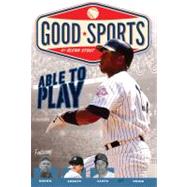
What is included with this book?
The New copy of this book will include any supplemental materials advertised. Please check the title of the book to determine if it should include any access cards, study guides, lab manuals, CDs, etc.
The Used, Rental and eBook copies of this book are not guaranteed to include any supplemental materials. Typically, only the book itself is included. This is true even if the title states it includes any access cards, study guides, lab manuals, CDs, etc.
Mordecai Brown and the Curveball
There is an old saying that goes "Sometimes life throws you a curveball," which means life might not always be easy or go according to plan. That is exactly what happened to young Mordecai (MORE-duh-kye) Brown. Yet just because life threw Mordecai a curveball, he didn’t give up. In fact, he learned to use his misfortune to help throw a curveball.
Born Mordecai Peter Centennial Brown in 1876 and named after the nation’s centennial, Mordecai was raised on a farm in rural Indiana. One day when he was five years old, his life changed.